|
|
|
Sort Order |
|
|
|
Items / Page
|
|
|
|
|
|
|
| Srl | Item |
| 1 |
ID:
175475


|
|
|
|
|
| Summary/Abstract |
Although much has been written about China’s Belt and Road Initiative (BRI), so far little attention has been paid to how Chinese investment is affecting workers in BRI-targeted countries. To explore this dimension of global China, this paper examines the labor rights situation at Chinese-owned construction sites in Sihanoukville, a city on the Cambodian coast that in recent years has been described as embodying the worst excesses of Chinese foreign investment. Based on extensive interviews with Chinese and Cambodian workers, this paper argues that while Chinese-owned construction sites in Cambodia are grounded in a labor regime as exploitative as those in mainland China, workers’ agency in the former case is further undermined by their employers’ adoption of a policy of labor force dualism that draws boundaries between Chinese and Cambodian workers.
|
|
|
|
|
|
|
|
|
|
|
|
|
|
|
|
| 2 |
ID:
168130
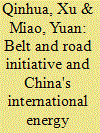

|
|
|
| 3 |
ID:
168129
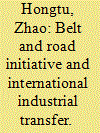

|
|
|
| 4 |
ID:
170851
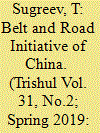

|
|
|
| 5 |
ID:
170622
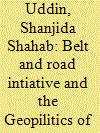

|
|
|
|
|
| Summary/Abstract |
This paper examines how China’s latest mega plan – the Belt and Road Initiative (BRI) will influence the geopolitics of energy. With a massive change in global energy supply and demand, the transition of international energy order is in the making. While the USA is going towards more isolationist path from its traditional superpower role, there are growing economies such as China, India, Japan and Russia which are undoubtedly playing important role on geopolitical stage. Several regions such as Central Asia, the Arctic, Eastern Mediterranean and South China Sea are offering huge natural gas and oil reserves and drawing global attention to develop energy cooperation. This situation is profoundly influencing the transition of energy order. In this transition, BRI is supposed to play an important role. As a mega development strategy with strong geostrategic dimension, it aims at promoting interconnectivity and cooperation in infrastructure, trade and development among the participating countries. This mega plan offers plenty of investments, infrastructure constructions and industrial integration in the energy sector. In addition, China is trying to build alternative energy shipping routes for evading heavy dependence on traditional energy chokepoints, specifically on the Strait of Malacca. In doing so, the country is trying to establish a multilateral platform for promoting and protecting energy cooperation under BRI. This paper, therefore, attempts to observe how this mega plan will contribute in re-shaping the existing energy order as well as the geopolitics of energy with a focus on multilateral energy cooperation.
|
|
|
|
|
|
|
|
|
|
|
|
|
|
|
|
| 6 |
ID:
167275
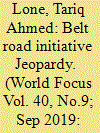

|
|
|
| 7 |
ID:
161952
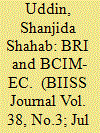

|
|
|
|
|
| Summary/Abstract |
The Belt and Road Initiative (BRI) is one of the largest development plans
initiated by China which includes 65 countries covering Asia, Africa and Europe.
While Bangladesh-China-India-Myanmar Economic Corridor (BCIM-EC) is a subregional cooperation that aims to introduce new impetus to economic and social
development by linking the southwestern parts of China with northeastern
region of India and the Bay of Bengal through Yangon and Mandalay in
Myanmar, and Bangladesh. Although BCIM-EC was initiated long before the
inception of BRI, China later incorporated it under BRI platform as one of the six
economic corridors. Instead of analysing why BCIM-EC was incorporated within
BRI, the paper attempts to focus on the impediments that BRI and BCIM-EC are
facing during implementation phase. Therefore, the paper limits its scope to
examine the impediments and investigate how China as a pioneer of BRI along
with member countries of both BRI and BCIM-EC can overcome these emerging
challenges. The paper attempts to formulate policy suggestions recommending
strategies for China to overcome these impediments with the assistance and
support of all the member countries of BRI and BCIM-EC.
|
|
|
|
|
|
|
|
|
|
|
|
|
|
|
|
| 8 |
ID:
165578
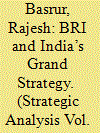

|
|
|
|
|
| Summary/Abstract |
India’s rejection of the BRI for strategic reasons does not mean it is resistant to Chinese investments, which are—to the contrary—both welcome and rapidly increasing. Indian strategy in this respect is in accord with the changing character of the international system, where strategic competition co-exists with economic cooperation as well as competition. In contemporary international politics, structurally driven conflictive behaviour is modified by high levels of strategic and economic interdependence. This incentivises India, like other major powers, to seek optimal gains through economic exchange even as it defends its strategic interests through military means short of war.
|
|
|
|
|
|
|
|
|
|
|
|
|
|
|
|
| 9 |
ID:
165577
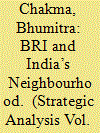

|
|
|
| 10 |
ID:
165581
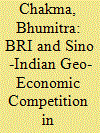

|
|
|
|
|
| Summary/Abstract |
This article explains the Sino-Indian geo-economic competition in Bangladesh in the wake of the former’s launching of the Belt and Road Initiative (BRI) in 2013. Beijing intends to fund various large-scale infrastructure projects in Bangladesh under the BRI which has prompted India to make its own offer of economic assistance to counter the Chinese initiative. The Sino-Indian competition has created challenges and opportunities for Bangladesh. Dhaka is pursuing a balanced policy to manage the competition and advance its own interests.
|
|
|
|
|
|
|
|
|
|
|
|
|
|
|
|
| 11 |
ID:
180313
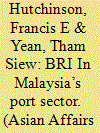

|
|
|
|
|
| Summary/Abstract |
The Belt and Road Initiative (BRI) has been characterised as a large-scale initiative to boost the movement of goods and services, capital, and people from China to Southeast Asia and beyond. Transport and logistics are a key aspect of this enterprise, with many projects focussing on railways, road networks, and ports receiving priority attention. However, BRI-related initiatives are often cast in unitary terms, with agency and autonomy almost uniquely ascribed to China-based firms and funders, and very little attributed to host country agents or their interests. Since 2013, Malaysia has received substantial inflows of BRI-related funds for infrastructure, particularly railways and ports. The Kuantan Port Expansion on Peninsular Malaysia's East Coast and the Melaka Gateway on its West Coast are two port-centred development projects associated with the BRI. Begun at the same time, these initiatives are similarly structured, as joint ventures linking large China-based state-owned enterprises with local players. Despite their similarities, these two projects have followed vastly different trajectories. While the Kuantan Port Expansion is proceeding according to schedule, the Melaka Gateway lies mired in delays and controversy. Through comparing and contrasting these two projects, this article will explore how – despite China's financial and political influence – host country actors can and do oppose, subvert, and even veto infrastructure initiatives perceived as inimical to their interests.
|
|
|
|
|
|
|
|
|
|
|
|
|
|
|
|
| 12 |
ID:
176571
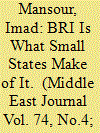

|
|
|
|
|
| Summary/Abstract |
Kuwait's expanding engagement with China's Belt and Road Initiative (BRI) sheds light on its strategies to meet its socioeconomic needs and navigate the Gulf's adversarial politics. The BRI presents a good case study of how the Kuwaiti leadership evaluates the benefits of and dilemmas created by asymmetric structural relationships. This article thus explores how governmental agency in strategically managing massive financial assets complicates our understanding of the vulnerability of so-called small states.
|
|
|
|
|
|
|
|
|
|
|
|
|
|
|
|
| 13 |
ID:
164418
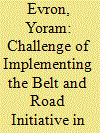

|
|
|
|
|
| Summary/Abstract |
Sceptics query China's economic and political ability to realize its Belt and Road Initiative (BRI). Less attention has been paid to BRI's implications for one of the defining features of China's foreign policy: low engagement in areas beyond its traditional sphere of influence. The Middle East is such a case. Addressing this issue, the article explores the mutual impact of China's low political involvement in the Middle East and BRI's realization. Distinguishing cross-border connectivity projects from other BRI-associated activities, the article examines the challenges to executing BRI-related projects in Israel. It finds that realizing connectivity projects – the essence of the BRI vision – will require China to increase its regional engagement, a shift that it has so far avoided.
|
|
|
|
|
|
|
|
|
|
|
|
|
|
|
|
| 14 |
ID:
173801
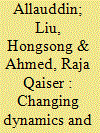

|
|
|
|
|
| Summary/Abstract |
The China–Pakistan relation has historical underpinning. By establishing diplomatic relations in 1951, each passing decade has witnessed that China–Pakistan relations coalesce into a dependable friendship. This relationship has gone beyond the usual diplomatic and political comfortability transcending to a broad-based framework incorporating economics, trade and defence dimensions. In the given context, this paper is an empirical study aiming to examine the historical process in the gradual culmination of China–Pakistan relations into a broad-based partnership. It further evaluates the present nature of relationship between the two countries and the prospects it holds in the wake of changing world scenario. By primarily focusing on the secondary sources of data and interviewing key people from the decision-making circles, this paper argues that the China–Pakistan relation is deep-rooted in the history and the on-going collaboration between China and Pakistan in defence and economy is the natural evolution of their mutual ties.
|
|
|
|
|
|
|
|
|
|
|
|
|
|
|
|
| 15 |
ID:
164072
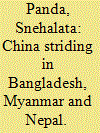

|
|
|
|
|
| Summary/Abstract |
China has pulled into its orbit relatively poor South Asian countries like Bangladesh, Myanmar and Nepal by extensive economic support and investments in infrastructure development. Bangladesh and Myanmar are important for accessing strategically located ports which will provide it alternative sea routes for unimpeded trade and commerce. Nepal is important to tighten its border with Tibet. Moreover, it is a cleverly planned strategy to access their market, supply military equipment and eclipse India’s influence in these countries. But it is no cakewalk as big international powers are countering China through diplomatic and economic means to constrict its growing influence in South Asia. The local communities are averse to its aid and investment as they apprehend that the projects are intended to benefit the investor and endanger their livelihood as well as environment while governments in each of these countries are striving to balance their relationship with big powers.
|
|
|
|
|
|
|
|
|
|
|
|
|
|
|
|
| 16 |
ID:
184396
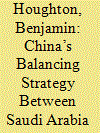

|
|
|
|
|
| Summary/Abstract |
Since Deng Xiaoping's opening-up policy and drive for economic modernisation and reform in the late 1970s, and especially since China's foreign energy requirements skyrocketed in 1993, Beijing's interests in the Persian Gulf have grown immensely. A staple of its regional policy has been an insistence on cultivating relations with all states, something that has necessitated a careful balancing act between regional rivals, especially Saudi Arabia and Iran. This article examines China's strategy to balance relations with these two states, especially during periods of tension, such as following the 2019 drone attacks on Saudi oil facilities, something that Riyadh accused Iran of masterminding. Following an examination of this strategy, the article explores Saudi attempts to coax Beijing away from Tehran and Saudi perceptions of Sino-Iranian relations through the lens of the 2021 25-year agreement between China and Iran, questioning whether Sino-Iranian relations are a bone of contention in Sino-Saudi relations.
|
|
|
|
|
|
|
|
|
|
|
|
|
|
|
|
| 17 |
ID:
169578
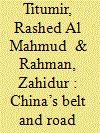

|
|
|
|
|
| Summary/Abstract |
The article provides a unique analytical framework to identify the compulsions and contradictions arising out of China’s Belt and Road Initiative (BRI) and offers feasible sets of solutions amidst burgeoning growth of literature on BRI which is either marred in assertive dogmatization, or excessive apprehensions, or non-feasible utopian (lack of) solutions. The proposed analytical framework, combining necessary and sufficient conditions for deriving gains from new form of cooperation under BRI, suggests integration of production network, transfer of technology and risk-sharing of capital for achieving mutual stability and growth outcomes. The article also deals with alignment of domestic political settlement and normative legitimacy by proposing an equiangular balanced pathway for development for the participating countries with particular emphasis on Bangladesh.
|
|
|
|
|
|
|
|
|
|
|
|
|
|
|
|
| 18 |
ID:
189227
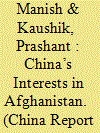

|
|
|
|
|
| Summary/Abstract |
Though long in the offing, US withdrawal from Afghanistan became a reality with the signing of the Doha Agreement on 29 February 2020, ultimately leading to the establishment of Taliban 2.0 in Kabul. The unravelling of the two-decade-old US-led war and reconstruction effort in Afghanistan led to a long-predicted scramble among the regional powers to fill the vacuum created by US withdrawal and threw up a plethora of intriguing questions, particularly regarding China’s role and interests in the region. This article seeks to understand and analyze China’s ever-growing engagement in Afghanistan through the paradigm of Realism, arguing that China has long-term geo-strategic and geo-economic interests in the region which requires it to coordinate more closely with Pakistan and Iran and innovate diplomatically. This article is divided into two sections. The first section focuses on China’s interests in Afghanistan viz. BRI-CPEC extension in Afghanistan, rare earth, and the need to ensure peace and stability. The second section assesses China’s response to the emerging situation by focusing on China’s engagement with the Taliban 2.0 and co-opting of Pakistan and Iran for safeguarding its long-term interests. This article concludes while looking at the position of India in the gamut.
|
|
|
|
|
|
|
|
|
|
|
|
|
|
|
|
| 19 |
ID:
192935
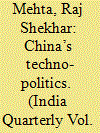

|
|
|
|
|
| Summary/Abstract |
The impact of China’s Digital Silk Road (DSR) on countries signing the Belt and Road Initiative (BRI) is a less explored area. This article argues that the repercussions of unregulated propagation of DSR on BRI countries are likely to go beyond economy and commerce because of the vastly different approach of China’s use of technology in its own governance. Since this aspect is inadequately covered in existing literature, an attempt is made to fill the gap. When external entities are allowed to setup large-scale digital networks, e-governance and e-commerce in technologically deficient countries of the Global South, the host country loses control over its digital data that such networks generate. Overdependence on technology of one nation can lead to a data monopoly with a potential impact on the entire polity. To what extent this hypothesis holds substance is the issue deliberated on in this article using inductive reasoning and qualitative methods.
|
|
|
|
|
|
|
|
|
|
|
|
|
|
|
|
| 20 |
ID:
165729
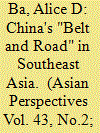

|
|
|
|
|
| Summary/Abstract |
China's Belt and Road Initiative (BRI) is viewed by most as symbolic of a new era of Chinese initiative and ambition. But while much attention has focused on how the BRI fits into China's—and specifically Xi Jinping's—grand narrative of national rejuvenation, less has been said about regional narratives—that is, the narratives of China's target audiences. Toward addressing this oversight, I consider the case of Singapore in relation to BRI. Specifically, I give attention to strategic narratives that offer analytic windows into the complex relationships being negotiated between China and Southeast Asian states. Strategic narratives, as instruments of policy, also play roles in constructing the strategic space in which BRI enters, with implications for the opportunities and constraints faced by China in Southeast Asia.
|
|
|
|
|
|
|
|
|
|
|
|
|
|
|
|
|
|
|
|
|